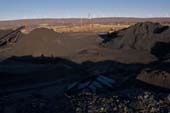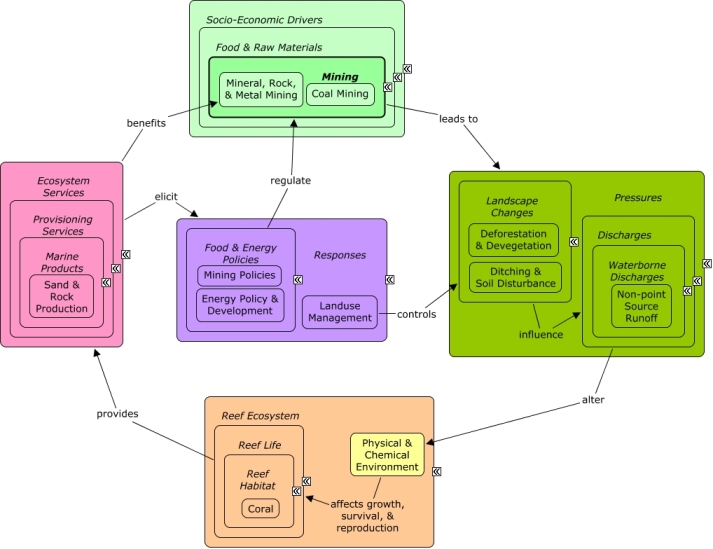ReefLink Database

Coal Mining
The Mining Industry consists of the operation of mines, quarries, and wells, and the extraction of natural resources, such as solid and liquid minerals and gases, from the earth (NAICS 2007). Coal mining removes coal from the ground, valued for energy production.
CMap

CMap Description
Mining activities often lead to devegetation and soil disturbance that can increase runoff of sediments and toxic chemicals into the physical & chemical environment, and affect survival and growth of reef species. Mining sectors benefit indirectly from ecosystem services that improve the well-being of sectors, such as tourism & recreation, which drive coastal development and the need for mining activities. Energy and mining policies can be enacted to regulate mining activities to reduce erosion or discharge. Landuse management can be applied in permitting and remediation.Citations
More than 50 citations. Click here to load.
| Citation | Year | Study Location | Study Type | Database Topics |
|---|
Management Options
| Management Option | Description | Sources | Database Topics |
|---|---|---|---|
| Energy Policy & Development: Develop Energy Efficiency Initiatives | Energy efficiency is one of the lowest cost strategies for reducing greenhouse gases. Energy efficiency is also one of the few options that actually reduce user costs as well, since using less energy should reduce energy bills. Energy efficiency can be promoted across the residential, commercial, and industrial sectors. In the US, the ENERGY STAR program has served as a trusted source of information to help consumers and organizations throughout the nation adopt energy-efficient products and practices. Other ways to incentivize energy improvements include subsidizing (e.g. tax exemption) or issuing lower interest loans for investments in energy use reduction technologies and infrastructure (e.g. more efficient heating/cooling systems). | Environmental Protection Agency. ENERGY STAR and Other Climate Protection Partnerships. 2009 Annual Report. US EPA. |
Atmospheric Emissions; City Planning; Climate Regulation; CO2; Coal Mining; Construction Codes & Projects; Corporate Responses; Discharges; Economic Markets & Policies; Energy Policy & Development; Food, Beverage, & Tobacco Products; Funding & Incentives; Greenhouse Gas Emissions; Housing; Improved Technology; Landuse Management; Manufacturing & Trade; Metals, Electronics, & Machinery Products; Oil & Gas Industry; Shelter; Utilities; Utility Policies; Wholesale & Retail Trade; Wood, Plastics, & Chemical Products |
| Landuse Management: Mine Reclamation | Lands disturbed by mining must be reclaimed to their Approximate Original Contour (AOC). Mine operators must backfill, compact, and grade in order to restore the AOC of the land with all highwalls, spoil piles, and depressions eliminated. Spoil material is prone to erosion, and may carry various disturbed toxics into groundwater if not properly managed. Temporary roads and impervious surfaces may have also been constructed for mining purposes. | Natural Resources Conservation Service. 2011. National Handbook of Conservation Practices. U.S. Department of Agriculture. Office of Surface Mining Reclamation and Enforcement. POSTMINING LAND USE: Exceptions to Approximate Original Contour Requirements for Mountaintop Removal Operations and steep Slope Mining Operations. Washington, DC. |
Chemical Use Regulations; Civil Engineering & Construction; Coal Mining; Construction Codes & Projects; Decision Support; Deforestation & Devegetation; Discharge Limitations; Discharges; Ditching & Soil Disturbance; Ecosystem Monitoring & Restoration; Environmental Monitoring & Restoration; Environmental Monitoring, Mapping, & Scientific Research; Food & Raw Materials; Hydrologic Management; Impervious Surfaces; Infrastructural Policies; Land-Based Civil Engineering; Landscape Changes; Landscape Conservation & Restoration; Landuse Management; Manufacturing & Trade; Manufacturing & Trade Policies; Mineral, Rock, & Metal Mining; Mining; Mining Policies; Mitigation; Non-point Source Controls; Non-point Source Runoff; Physical & Chemical Water Quality Criteria; Political Pressure; Remediation; Resource Use Management; Sediment; Surface & Groundwater Flow; Toxics; Valuation; Waterborne Discharges |
| Restoration: Land Reclamation Integrating Toxic Discharge Controls | This option aims to eliminate unsightly residues, reduce erosion and control acid or otherwise toxic aqueous discharges from abandoned coal mines, coalmine waste or other types of land change. For toxic mine drainage, preventative actions include mine sealing, infiltration control, day lighting, and neutralization with alkaline material such as hydrated lime. Which action to take relies heavily on groundwater and runoff in the region of the mine. | Natural Resources Conservation Service. 2011. National Handbook of Conservation Practices. U.S. Department of Agriculture. |
Aquaculture; Coal Mining; Discharge Limitations; Discharges; Ditching & Soil Disturbance; Hydrologic Management; Mineral, Rock, & Metal Mining; Mining; Mining Policies; Non-point Source Controls; Ocean Acidity; Surface & Groundwater Flow; Toxics; Waterborne Discharges |
Laws
| Legal Citation | Purpose of Law | Management Organization | Database Topics |
|---|---|---|---|
| Water quality based effluent limitations, 62-650 Florida Administrative Code Annotated (1996). | To implement the provisions of Section 403.051, 403.085 through 403.088 concerning the development of effluent limitations for wastewater facilities. Application to Coral Reefs:The Florida Air and Water Pollution Act establishes that no wastes are to be discharged to any waters of the state without first being given the degree of treatment necessay to protect the beneficial uses of such water. Requiring treatment of industrial and domestic waste water indirectly protects adjoining ecosystem, such as reefs, by limiting the pollutant that reach these other systems. Legislative Actions:The Department shall not issue a permit for a discharge to waters of the state, unless the Department has established an efflent limit for those pollutants in the discharge that are present in quantities or concentrations which can be reasonably expected to cause or contribute, directly or indirectly, to a violation of any water quality standard established in rule 62-302. The effluent limit may be a technology based effluent limit (TBEL), a water quality based effluent limit (WQBEL) determined by a Level 1 process, or where applicable, a WQBEL determined by a Level 2 process. Comments: |
Florida Department of Environmental Protection Jurisdiction: US State Waters; Designated Marine Areas |
Agriculture, Aquaculture, & Forestry Policies; Applied Chemicals; Building & Home Construction; Cleaner & Solvent Use; Coal Mining; Construction Codes & Projects; Dam Construction & Maintenance; Domestic Animal Waste; Dredging, Draining, & Filling; Fertilizer & Pesticide Use; Finfish & Shellfish Stock; Fish; Food, Beverage, & Tobacco Products; Irrigation; Landuse Management; Lobster, Crab, & Shrimp; Metals, Electronics, & Machinery Products; Mineral, Rock, & Metal Mining; Non-point Source Runoff; Nutrient & Contaminant Processing; Nutrients; Physical & Chemical Water Quality Criteria; Point Source Discharges; Road Construction & Maintenance; Sediment; Sewage Treatment; Solid Waste Disposal; Utility Line Construction & Maintenance; Waste Management Policies; Wastewater Discharge; Waterborne Discharges; Wholesale & Retail Trade; Wood, Plastics, & Chemical Products |
